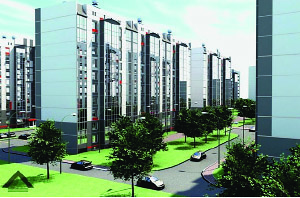 In 2015, Smolensk is gaining a new residential suburb, by the symbolic name of the Vitebsk Suburb, proclaiming Vitebsk as the blood brother of its Russian counterpart.
In 2015, Smolensk is gaining a new residential suburb, by the symbolic name of the Vitebsk Suburb, proclaiming Vitebsk as the blood brother of its Russian counterpart.
The first five-story building stands on former wasteland, while a second 3-access apartment block is almost complete, and the construction of a third building has begun. “By the end of 2015, there will be 13 such blocks, unified in style, surrounded by landscaped gardens, children’s playgrounds, and sports and recreation areas — perhaps even a kindergarten,” explains Anton Idirisov, the Director General of SU-197 CJSC.
Windows begin just 50cm from the floor, ensuring light and a spacious feel to rooms, while offering wonderful city views. Each building stands out for its modern facade of stylish glass. Despite appearing cutting edge, the apartments are perfectly affordable, with the model being used by Belarusian designers in Kaluga and Pskov, as well as in Smolensk.
Gomel’s Integrated House-Building Factory has been delivering panels for construction, while Gomel residents have established themselves as first-class builders. Vasily Yuriev, an electric welder at Gomel’s Integrated House-Building Factory, comments, “We work in shifts, with food and accommodation provided by the receiving party. We feel very comfortable in Smolensk.”
Year on year, Belarusian-Russian co-operation is gaining momentum in the building sphere, with ever wider use of modern materials and technologies.
The Kaluga Region is gaining a Malinovka Suburb (named after that in Minsk) while Gomel residents are building approximately 210,000 square metres of housing in Kursk, and Belarusians are laying underground tunnels in Moscow. In 2015, Belarusian builders are set to generate around a billion Dollars equivalent in service exports.
By Anastasia Shoplya











